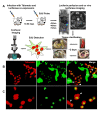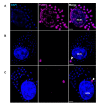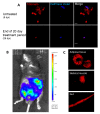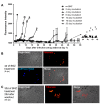Spontaneous dormancy protects Trypanosoma cruzi during extended drug exposure
- PMID: 29578409
- PMCID: PMC5906098
- DOI: 10.7554/eLife.34039
Spontaneous dormancy protects Trypanosoma cruzi during extended drug exposure
Abstract
The ability of the Chagas disease agent Trypanosoma cruzi to resist extended in vivo exposure to highly effective trypanocidal compounds prompted us to explore the potential for dormancy and its contribution to failed drug treatments in this infection. We document the development of non-proliferating intracellular amastigotes in vivo and in vitro in the absence of drug treatment. Non-proliferative amastigotes ultimately converted to trypomastigotes and established infections in new host cells. Most significantly, dormant amastigotes were uniquely resistant to extended drug treatment in vivo and in vitro and could re-establish a flourishing infection after as many as 30 days of drug exposure. These results demonstrate a dormancy state in T. cruzi that accounts for the failure of highly cytotoxic compounds to completely resolve the infection. The ability of T. cruzi to establish dormancy throws into question current methods for identifying curative drugs but also suggests alternative therapeutic approaches.
Keywords: Chagas disease; Trypanosoma cruzi; dormancy; drug resistance; infectious disease; microbiology.
© 2018, Sánchez-Valdéz et al.
Conflict of interest statement
FS, AP, WW, DO, RT No competing interests declared
Figures














References
-
- Álvarez MG, Hernández Y, Bertocchi G, Fernández M, Lococo B, Ramírez JC, Cura C, Albizu CL, Schijman A, Abril M, Sosa-Estani S, Viotti R. New scheme of intermittent benznidazole administration in patients chronically infected with trypanosoma cruzi: a pilot short-term follow-up study with adult patients. Antimicrobial Agents and Chemotherapy. 2016;60:833–837. doi: 10.1128/AAC.00745-15. - DOI - PMC - PubMed
-
- Canavaci AM, Bustamante JM, Padilla AM, Perez Brandan CM, Simpson LJ, Xu D, Boehlke CL, Tarleton RL. In vitro and in vivo high-throughput assays for the testing of anti-Trypanosoma cruzi compounds. PLoS Neglected Tropical Diseases. 2010;4:e740. doi: 10.1371/journal.pntd.0000740. - DOI - PMC - PubMed
Publication types
MeSH terms
Substances
Grants and funding
LinkOut - more resources
Full Text Sources
Other Literature Sources
Research Materials

